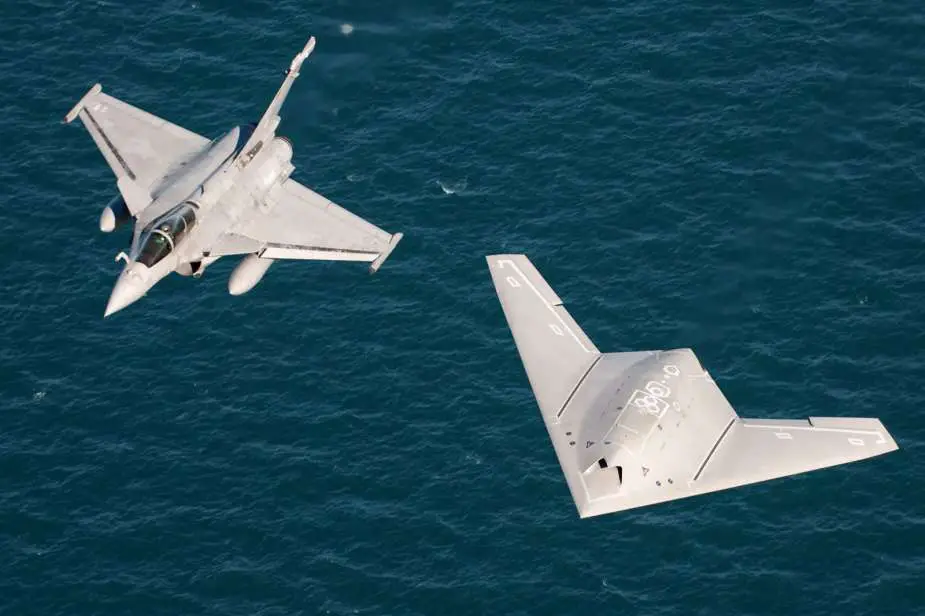Breaking news
A drone linked with French Rafale F5 to be key component in handling enemy anti-aircraft systems.
With the proliferation of Anti-Access/Area Denial (A2/AD) capabilities and the return of high-intensity conflict, the idea of developing a dedicated Rafale variant for electronic warfare, similar to the American E/A-18G Growler, is now regularly discussed, Laurent Lagneau writes in Opex360. This is especially relevant since the French Air and Space Army (AAE) has lost the capability to suppress and destroy enemy air defenses (SEAD - Suppression of Enemy Air Defenses).
Follow Air Recognition on Google News at this link
 Rafale M and nEUROn drone (Picture source: Dassault Aviation)
Rafale M and nEUROn drone (Picture source: Dassault Aviation)
For the French Ministry of Armed Forces, developing a Rafale dedicated to electronic warfare does not appear necessary to ensure the operational superiority of the AAE. This is because Rafale's self-protection system (SPECTRA) is constantly evolving, enabling it to have increasingly robust threat detection and jamming capabilities adapted to new threats.
However, the evolution of SPECTRA does not address the capability gap in SEAD. This gap is expected to be filled with the Rafale F5, the development of which has been confirmed by the 2024-30 Military Programming Law. Before the operationalization of the Future Combat Air System (FCAS), which will be inherently suited to the most challenging environments by 2040, the developments of the Rafale and its armament will provide the AAE with a credible capability to destroy enemy defenses by 2030-35, according to the Ministry of Defense.
The Rafale F5 will be a very different aircraft compared to the current F3R and F4 standards. It will need to be capable of carrying the future nuclear-capable ASN4G missile and processing enormous volumes of data, requiring optical fiber cabling that current versions cannot support. It will be accompanied by a combat drone from the nEUROn program, led by Dassault Aviation, as part of European cooperation. This combat drone will act discreetly and rapidly as an extension of the Rafale F5 to produce decisive effects in a networked environment. With these characteristics, this aircraft should be a cornerstone in dealing with modern medium and long-range anti-aircraft systems. Furthermore, some munitions carried by the Rafale F5 will be capable of destroying both powerful and mobile air defense systems.
The aim of the nEUROn demonstrator is to provide the European design offices with a project allowing them to develop know-how and to maintain their technological capabilities in the coming years. This project has gone far beyond the theoretical studies that have been conducted until now, as it plans the building and the flight demonstration of an unmanned aircraft. It is also a way to implement an innovative process in terms of management and organization of a European cooperative programme.
To be fully effective, a single point of decision, the French Defence Procurement Agency (DGA – Délégation Générale pour l’Armement), and a single point of implementation, Dassault Aviation company as prime contractor, were settled to manage the nEUROn programme. The Italian, Swedish, Spanish, Greek and Swiss governments acting together with their related industrial teams, Alenia, SAAB, EADS-CASA, Hellenic Aerospace Industry (HAI) and RUAG, have joined the French initiative.
According to the French Defense Ministry, there are plans to develop a version of the Future Anti-Ship Missile/Future Cruise Missile (FMAN/FMC) adapted for the destruction of ground-based air defense systems. The Ministry also mentions onboard and launched electromagnetic spectrum saturation systems, which will better address the needs of countering access denial and area denial devices. Such means will complement the future air-to-ground armament (AASF).
In any case, in a high-intensity conflict, and even though the aerial domain is likely to remain predominant in the application of these military effects, the Ministry of Armed Forces believes that the suppression of enemy air defenses must be considered through an inter-service and multi-environment approach to leverage a wide range of complementary capabilities, Laurent Lageau reports.

























